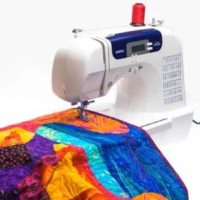Are you on a lookout to learn how to sew with a sewing machine for beginners? You are in luck here and have come to the right place. Sewing is one of the most important and useful skills that we can acquire. Oftentimes it is even necessary as we have to do emergency repairs and quick fixes by ourselves. It isn’t too difficult also to wield a needle and a thread and start making quick stitches for simple repairs. However, you can do so much more with a sewing machine.
Sewing on a sewing machine is not all too difficult. In fact you can even teach yourself how to use one without attending any formal sewing class. Sewing machines may just sound intimidating and something meant for professional seamstress and tailors. However, anyone can actually be able to use them, even the beginners and novices. In fact, there are sewing machines meant for kids these days. Using a sewing machine is meant for everybody. All you have to do is learn how to use it.
Getting a Sewing Machine First – How to Sew With a Sewing Machine
The first step to learn how to sew on a sewing machine for beginners is of course to get a sewing machine first. There are a lot of sewing machines available on the market. You have cheap sewing machines, expensive sewing machines. You have mechanical and computerized sewing machines. You have basic machines and heavy duty sewing machines. Practically every group category that you can think of, there are sewing machine models suited for them.
You need to find a sewing machine that is perfect for you however. Otherwise, your sewing machine could sit uselessly in your work room because it is too complicated to work on or it doesn’t have the functions that you need. First consider your usage. If you just want to make simple repairs and sewing works, then getting a simple, basic machine would be best for you. However, if you want more complicated projects to be done yet want to keep your investment at a minimum, then you have to find an intermediate sewing machine that finds the balance of functionality and price.
Also remember to purchase your sewing machine from a reputable store that offers nice after sales service and product warranty. If you don’t purchase your sewing machine in reputable distributers, the product warranty may be void. Although sewing machines are generally durable and long term investments, there could be a possibility that you will get a defective product.
Familiarizing with the Different Parts of a Sewing Machine
Before you start sewing on your new sewing machine, you have to familiarize with the different parts in order to be able to operate it. Different machine may have different parts depending on their functions. The placement of these parts could also be different. But you can refer to your instruction manual provided by the sewing machine manufacturer. Some of the key parts that you need to know are:
- Spool pin – This is where you place your spool of thread, usually located at the top of your sewing machine.
- Bobbin winder – This is used to wind your bobbin. You have the bobbin pin and winding disc on top of your machine.
- Needle – Need we say more?
- Drop feed – This holds your fabric in place. The drop feed lever is what is used to operate the drop feed lever to go up and down.
- Feed dog. This is what guides your fabric as it pushes it forward or backward as you sew.
- Hand wheel. This is located at the rightmost of your sewing machine and used to manually operate your sewing machine. Ideally this is used for threading the machine or testing out stitches.
- Foot pedal. This is what you step on to get your machine in motion.
There are many other parts of the sewing machine but those are the top parts/functions that you will be using. Once you get to know these vital parts, you can now move on to the next step.
Fabric, Thread and Stitch Choice
Different fabrics would require different treatment. This means that you have to know and understand your fabric choice and see what works best with it. If you choose a wrong needle and stitch for certain fabrics, you could end up ruining it. The fabric may run or tear.
You have to understand the different kinds of fabric available. You have lightweight fabrics which are thin and sheer and very delicate. You also have heavy fabrics which are thick and require a stronger needle to work with it. You also have woven and knit fabrics that require different needles.
You may also require different kinds of thread depending on the kind of project you are doing. Embroidery threads are different from your regular sewing threads used for repairing and simple clothing. These threads also require a special kind of needle to ensure that the delicate threads do not break.
All in all, there should be a harmony in your choice of fabric, thread and stitches. They are all connected and you need to work on this harmony to produce quality sewing work. You can perfect this through practicing with different kinds of fabric, needles and thread.
Practicing Stitches
Now that you are familiar with your sewing machine and with the different kind of fabric, needles and stitches, you can already start sewing. Practice sewing that is. You need to practice on a few stitches first before trying out the real thing.
What you need to do first is make sure that your machine is properly threaded. Otherwise, your sewing machine could jam up. Be sure to wind your bobbin first before you proceed threading your machine and bobbin. Sewing machines often use double threads now thus the need for winding and threading bobbins. There will be a threading guide for your machine. Please follow that strictly to avoid any potential problems that may rise from not threading your machine properly.
Once you are done threading your machine, you can now start to practice your stitches. We suggest you try a straight stitch first. Adjust the settings accordingly and choose the stitch length as well. Then raise the drop feet lever to allow your fabric to go under the needle. Position your fabric under the needle and lower the drop feet lever. This will hold your fabric securely. Pull the thread from your spool and bobbin and continue holding it for the next few stitches. You can slowly control the first few stitches by using the hand wheel. Make sure that the stitches have already caught on before letting go of the threads. Hold the fabric securely and carefully before stepping slowly on the foot pedal. This will propel your machine to start sewing. Guide the fabric into the machine so you will have straight stitches. Continue practicing until you perfect this before trying a different stitch. Continue practicing until you are confident enough to try real sewing projects. Soon enough, you will be sewing like a pro.
The Most Common Issues with a Sewing Machine Video
We hope you liked out “learn how to sew with a sewing machine” guide. Sewing on a sewing machine surely beats sewing by hand. It gives you stitch precision and accuracy as well as speed. So why continue sewing by hand when you can have a much more convenient way of doing it? Get your very own sewing machine and start honing those sewing skills.


